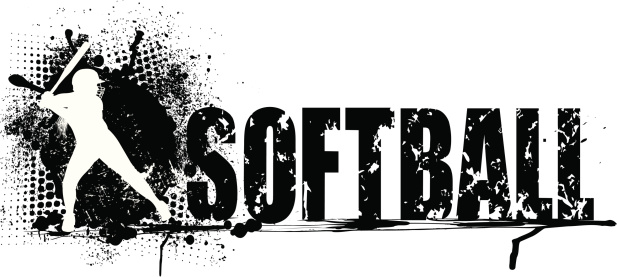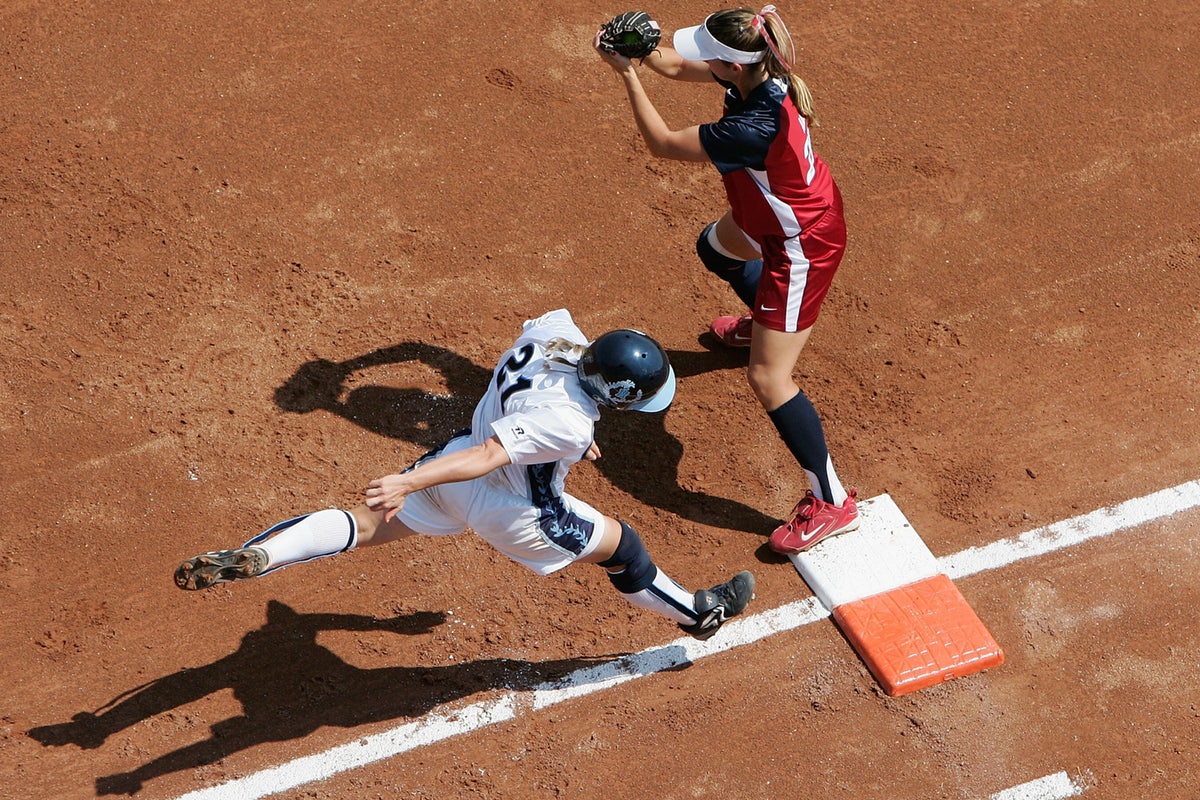 First Base Checklist of Responsibilities:
First Base Checklist of Responsibilities:
Positioning Yourself
Fielding Bunts
Picks in Dirt
Steal situations – communication with second base
Throwing to Bases: force plays, tag plays, bunts
Receiving Throws: force plays, tag plays, bunts
Pop-Ups: communication and playing the fence/dugout
Rundowns
Relay Footwork / Double Cut Situation
Positioning (cutoffs, in front, even, behind, deep)
Slow rollers
Pickoffs
Reading Bat Angles, Swings, and Pitcher’s velocity
FIRST BASE (1B)
Yes, the first baseman’s first responsibility is to get to the bag and set a good target for her infielders, but a truly great first baseman is an outstanding athlete with an awareness of her varied responsibilities. The better she masters each skill involved with her position, the better chance her team will have at winning those close games. The necessary skills don’t happen, they must be taught, then practiced
Main Responsibilities of First Baseman:
– Field balls hit into her zone: be aggressive and fill the hole between first base & the second baseman because the pitcher will cover first base if the 1st baseman on balls hit to the right side of the infield.
– Be the cut off person to home on balls hit to Right Field when there is a runner in scoring position.
– Cover second base whenever there is a double cut involving the 2nd baseman and the shortstop.
Special Notes:
– The pitcher will come to cover the base anytime a grounder is hit on the right side of the infield just in case 1st baseman cannot get back to 1B before the batter.
– 2nd baseman will cover first base on a bunt to 1st baseman.
– 1st basemen should hustle to any pop up in their area. They should look to call of the catcher and let the 2nd baseman take priority on any ball hit behind the first base.
|
This position requires some specific skills just like the other eight, and they should be drilled into the candidates for first base. The primary responsibility is obvious. We want the first baseman to be able to get back to the bag and establish a good target for the throw. But this may not be as simple as it sounds. There are two basic approaches to accepting a throw at first. The first, and probably easiest, is for the player to set up with the heel of her foot against the bag, facing the thrower.
As the ball is released, the first baseman remains closed to the bag her feet about shoulder width apart. She stretches toward the ball as she determines the path of the throw while stretching towards the path of the throw, keeping one foot in contact with the bag, her foot in contact with the base should kick back on the bag. An inexperienced player may have trouble finding the bag without looking, but it does allow the player a bit more mobility on wide throws. The key is to commit to the stretch only after the ball is released by the thrower. A premature stretch may find the first baseman in no position to recover and get to the bad throw. This approach requires the first baseman to work extensively on her footwork going back to the bag as the ball is hit. She should avoid looking at the bag, perhaps just giving it a quick glance as she makes her initial move. This will allow her better reaction to the ball on those close plays that require her to catch the ball just as she arrives at the bag. Have the player work on a consistent pattern for going to the bag on pickoffs or groundballs. The footwork I prefer is for the players to drop step and pivot 180 degrees to her right, heading toward the proper corner of the bag. For pickoffs, she should head toward the corner closest to home on the baseline. As she approaches the corner, her left foot should plant right at this corner alongside the bag. As the left foot is planting, she will be looking over her left shoulder for the throw from the catcher which should be released just as the left foot is about to plant. The right foot will plant to the outfield side of the bag as the ball is being caught, and the first baseman will put the tag right on the second base side of the bag. The first baseman should always make this tag facing second base. If she turns the other way, swiping to her left, she may not find anyone there because a good runner will break for second, and most of the time find the first baseman unable to react quickly enough to make the throw to second. The first baseman must still remember she is still a fielder. She should make reasonable attempts to field balls hit to the right side, keeping in mind the pitcher should be covering first if necessary. The first baseman also needs a strong arm. Besides fielding bunts, she will be called upon to throw to all the bases from both first and her cut position around the mound. It is recommended that the first baseman never charge or position herself any closer than halfway up the line unless a ball is positively bunted. Charging any tighter will make the infield quite susceptible to a slap or push toward the four hole, and can cause confusion on balls slapped the other way. It is virtually impossible for a first baseman who charges tight to the plate to beat the batter to first. Therefore, don’t commit over halfway unless you are sure the ball is being bunted. An important reminder to your player at this position is to tell her as she tightens to the plate, she should tighten to the line to compensate for the lost reaction time. Both the first and third basemen move closer to the plate and the foul lines as they tighten up. When she must out-sprint the batter to first, run to the inside part of the bag to avoid contact with the runner, catch the ball just prior to reaching the base, then carry the ball through the base. First basemen, must also remember to avoid contact with the runner on base hits. This is a common area for obstruction to occur if the fielder remains in or close to the base path while the runner tries to turn toward second. If the ball is a definite hit, turn to be sure the runner touches the bag and doesn’t make a move toward second. Then communicate to whoever is taking the throw back into the infield to let her know whether the runner is attempting to advance or not. On base hits to the outfield with a runner at second, gap shots with a runner at first, or fly balls with a runner at first, or fly balls with a runner at third, the first baseman normally acts as the cut person, positioning herself at the pitcher’s mound distance (40 – 45 feet away from the plate) in line with the throw. If she is left-handed, she will glance over her right shoulder, and if righty, over her left shoulder to be sure she is in line to make the quickest relay home if necessary. If she can see the plate out of the corner of her eye as she glances, she will be in perfect position to pivot to throw home. Always pivot toward the glove hand. The catcher will help line her up. By prearranged signal she will be told by the catcher whether to “cut” the ball or not, then where the next throw will go. If the ball is not to be cut, the first baseman should fake the cut then fake her next throw in an attempt to hold the runner back. It is important to attempt to hold all runners as close to the bag as possible, so the first baseman and second baseman need to communicate in some way between themselves on each pitch, with a runner on first, as to who will be forcing the runner back to the bag and taking the potential pickoff throw. Any time the first baseman must charge the plate, regardless of the signal, the second baseman will have this responsibility. The first baseman, when she has no further play at first on an extra base hit may sometimes be called to follow the runner to second. Additionally, she may involve herself with rundowns anywhere in the infield. She must recognize wide throws and learn when it is best to come off the bag to prevent an overthrow that will result in additional bases for the runner. And she must practice the swipe tag on wide throws. She must also call out tag plays to the shortstop when ,with a runner on first, the first out of a double play attempt is made at first. Yes, the first baseman’s first responsibility is to get to the bag and set a good target for her infielders, but a truly great first baseman is an outstanding athlete with an awareness of her varied responsibilities. The better she masters each skill involved with her position, the better chance her team will have at winning those close games. The necessary skills don’t happen, they must be taught, then practiced |


